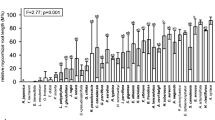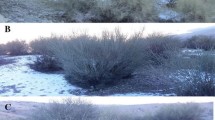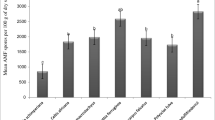Abstract
The aim of this work was to evaluate arbuscular mycorrhizal (AM) fungi as soil indicators and the mycorrhization of native and exotic tree species planted in the Acaraú basin, a transition area from the coast to the Brazilian semiarid region. Plots with 6-year-old trees of four native and three non-native species as well as one non-forested area were evaluated in terms of the diversity of AM fungi in the mycorrhizosphere and the root colonization by AM and ectomycorrhizal (EcM) fungi. Twenty-four AM fungi were identified; Claroideoglomus etunicatum, Glomus sinuosum, Paraglomus albidum, Acaulospora laevis, and Acaulospora brasiliensis were abundant in the forest soil. Diversity, dominance, evenness and richness indices of AM fungi were higher in plots with native trees. All root samples were colonized by AM fungi and only Anadenanthera colubrina, Acacia mangium, Casuarina equisetifolia and Eucalyptus urophylla formed associations with EcM fungi. Acaulospora morphotypes served as soil indicators for coverings with the native species Astronium fraxinifolium and Colubrina glandulosa. Exotic species may favor the proliferation of rarer AM fungi. These fungi–plant relationships may be important in the management of forest systems, and the evidence with mycorrhizal associations allows the inclusion of Brazilian species in tropical reforestation.


Similar content being viewed by others
References
Aggangan NS, Moon HK, Han SH (2010) Growth response of Acacia mangium Willd. seedlings to arbuscular mycorrhizal fungi and four isolates of the ectomycorrhizal fungus Pisolithus tinctorius (Pers.) Coker and Couch. New For 39(2):215–230
Aiala-Orozco B, Gavito ME, Mora F, Siddique I, Balvanera P, Jaramillo VJ, Cotler H, Romero-Duque LP, Martínez-Meyer E (2018) Resilience of soil properties to land-use change in a tropical dry forest ecosystem. Land Degrad Dev 29(2):315–325
Alvares CA, Stape JL, Sentelhas PC, Gonçalves JLM, Sparovek G (2014) Köppen’s climate classification map for Brazil. Meteorol Z 22(6):711–728
Bastin JF, Berrahmouni N, Grainger A, Maniatis D, Mollicone D, Moore R, Patriarca C, Picard N, Sparrow B, Abraham EM, Aloui K, Atesoglu A, Attore F, Bassüllü C, Bay A, Garzuglia M, García-Montero LG, Groot N, Guerin G, Lastadius L, Lowe AJ, Mamane B, Marchi G, Patterson P, Rezende M, Ricci S, Salcedo I, Diaz ASP, Stolle F, Surappaeva V, Castro R (2017) The extent of forest in dryland biomes. Science 356(6338):635–638
Beech E, Rivers M, Oldfield S, Smith PP (2017) Global tree search: the first complete global database of tree species and country distributions. J Sustain For 36(5):454–489
Bezerra CEE, Ferreira TO, Romero RE, Mota JCA, Vieira JM, Duarte LRS, Cooper M (2015) Genesis of cohesive soil horizons from northeast Brazil: role of argilluviation and sorting of sand. Soil Res 53(1):43–55
Brundrett MC, Tedersoo L (2018) Evolutionary history of mycorrhizal symbiosis and global host plant diversity. New Phytol 220(4):1108–1115
Brundrett MC, Bougher N, Dell B, Grove T, Malajcczuk N (1996) Working with mycorrhizas in forestry and agriculture. AClAR, Canberra. Monograph 32
Camara R, Fonseca Junior AM, Sousa ACO, Pereira MG, Oliveira Júnior JQ (2017) Influência do substrato e inoculação micorrízica na produção de mudas de Colubrina glandulosa Perkins. Rev Floresta 47(4):449–458
Campos DTS, Silva MCS, Luz JMR, Telesfora RJ, Kasuya MCM (2011) Colonização micorrízica em plantações de Eucalipto. Rev Árvore 35(5):965–974
Chandra LR, Gupta S, Pande V, Singh N (2016) Impact of forest vegetation on soil characteristics: a correlation between soil biological and physico-chemical properties. 3 Biotech 6:188. https://doi.org/10.1007/s13205-016-0510-y
Chazdon RL, Brancalion PHS, Laestadius L, Bennett-Curry A, Buckingham K, Kumar C, Moll-Rocek J, Vieira ICG, Wilson SJ (2016) When is a forest a forest? Forest concepts and definitions in the era of forest and landscape restoration. Ambio 45(5):538–550
Chen YL, Liu S, Dell B (2007) Mycorrhizal status of Eucalyptus plantations in south China and implications for management. Mycorrhiza 17(6):527–535
Dawkins K, Esiobu N (2017) Arbuscular and ectomycorrhizal fungi associated with the invasive Brazilian pepper tree (Schinus terebintholius) and two native plants in South Florida. Front Microbiol 8:665
Diagne N, Diouf D, Svistoonoff S, Kane A, Noba K, Franche C, Bogusz D, Duponnois R (2013) Casuarina in Africa: distribution, role and importance of arbuscular mycorrhizal fungi and Frankia on development. J Environ Manag 128:204–209
Dufrêne M, Legendre P (1997) Species assemblages and indicator species: the need for flexible asymmetrical approach. Ecol Monogr 67(3):345–366
Fonseca Filho IC, Bomfim BLS, Farias JC, Vieira FJ, Barros RFM (2017) Pau-d’arco-roxo (Handroanthus impetiginosus (Mart. Ex DC.) Mattos: conhecimento e uso madeireiro em comunidades rurais do Nordeste do Brasil. Gaia Sci 11(2):57–70
Giovannetti M, Mosse EB (1980) An evaluation of techniques for measuring vesicular arbuscular mycorrhizal infection in roots. New Phytol 84(3):489–500
Gonzalez SG, Torres-Arias Y, Ortega-Fors R, Gómes EF (2016) Hongos micorrizógenos arbusculares (Glomeromycota) de laplaya Santa Maríadel Mar, Cuba. Rev Jardin Botánico Nacional 37:81–84
IBÁ (Indústria Brasileira de Arvores) (2017) Brazilian tree industry—Report 2017. https://iba.org/images/shared/Biblioteca/IBA_RelatorioAnual2017.pdf. Accessed 10 Apr 2018
Liu X, Burslem DFRP, Taylor JD, Taylor AFS, Khoo E, Majalap-Lee N, Helgarson T, Johnson D (2018) Partitioning of soil phosphorus among arbuscular and ectomycorrhizal trees in tropical and subtropical forests. Ecol Lett 21(5):713–723
Magurran AE (2004) Measuring biological diversity. Blackwell Publishing, Malden and Oxford
Mello AH, Antoniolli ZI, Kaminski J, Souza EL, Oliveira VL (2006) Fungos arbusculares e ectomicorrízicos em áreas de eucalipto e de campo nativa em solo arenoso. Ciência Florestal 16(3):293–301
Mirzaei J, Moradi M (2017) Relationships between flora biodiversity, soil physiochemical properties, and arbuscular mycorrhizal fungi (AMF) diversity in a semi-arid forest. Plant Ecol Evol 150(2):151–259
Monteiro JM, Almeida CFCB, Albuquerque UP, Lucena RFP, Florentino ATN, Oliveira RIC (2006) Use and traditional management of Anadenanthera colubrina (Vell.) Brenan in semi-arid region of northeastern Brazil. J Ethnobiol Ethnomed 2(6):1–7
Moreira JMMA, Simion FJ, Oliveira EB (2017) Importância e desempenho das florestas plantadas no contexto do agronegócio brasileiro. Floresta 47(1):85–94
Mota LHSO, Valladares CS (2011) Vulnerabilidade à degradação dos solos da Bacia do Acaraú, Ceará. Rev Ciência Agron 42(1):39–50
Pagano MC, Zandavalli RB, Araújo FS (2013) Biodiversity of arbuscular mycorrhizas in three vegetational types from the semi-arid of Ceará state, Brazil. Apl Soil Ecol 67:37–46
Pedone-Bonfim MVL, Lins MA, Coelho IR, Santana AS, Silva FSB, Maia LC (2013) Mycorrhizal technology and phosphorus in the production of primary and secondary metabolites in cebil (Anadenanthera colubrina (Vell.) Brenan) seedlings. J Sci Food Agric 93:1479–1484
Pedone-Bonfim MVL, Silva DKA, Maia LC, Yano-Melo AM (2018) Mycorrhizal benefits on native plants of the Caatinga, a Brazilian dry tropical forest. Symbiosis 74(2):79–88
Pereira JES, Barreto-Garcia PAB, Scoriza RN, Saggin Júnior OJ, Gomes VS (2018) Arbuscular mycorrhizal fungi in soils of arboreal Caatinga submitted to forest management. Rev Bras Ci Agrar 13(1):e5497
Phillips JM, Hayman DS (1970) Improved procedures for clearing roots and staining parasitic and vesicular–arbuscular mycorrhizal fungi for rapid assessment of infection. Trans Br Mycol Soc 55(1):158–161
Retama-Ortiz Y, Ávila-Bello CH, Alarcón A, Ferrera-Cerrato R (2017) Effectiveness of native arbuscular mycorrhiza on the growth of four tree forest species from Santa Marta Mountain, Veracruz (Mexico). For Syst 26(1):1–9
Santos RS, Scoriza RN, Ferreira JS (2013) Fungos micorrízicos arbusculares em diferentes coberturas florestais de Vitória da Conquista Bahia. Floresta Ambiente 20(3):344–350
Sheldrake M, Rosenstock NP, Revillini D, Olsson PA, Mangan S, Sayer EJ, Wallander H, Turner BL, Tanner EV (2017) Arbuscular mycorrhizal fungal community composition is altered by long-term litter removal but not litter addition in a lowland tropical forest. New Phytol 214(1):455–467
Sieverding E (1991) Vesicular–arbuscular mycorrhiza management in tropical agrosystems. GTZ, Eschborn
Silva IR, Silva DKA, Souza FA, Oehl F, Maia LC (2017) Changes in arbuscular mycorrhizal fungal communities along a river delta island in northeastern Brazil. Acta Oecol 79:8–17
Silva UBT, Dalgado-Jaramillo M, Aguiar LMS, Bernard E (2018) Species richness, geographic distribution, pressures, and threats to bats in the Caatinga drylands of Brazil. Biol Conserv 221:312–322
Smith SR, Read D (2008) Mycorrhizal symbiosis, 3rd edn. Academic Press, New York. p, p 787
Sousa NMF, Veresoglou SD, Oehl F, Rillig MC, Maia LC (2018) Predictors of arbuscular mycorrhizal fungal communities in the Brazilian tropical dry forest. Microb Ecol 75(2):447–458
Souza TAF, Freitas H (2017) Arbuscular mycorrhizal fungal community assembly in the Brazilian tropical dry forest. Ecol Process 6(3):2–10
Toju H, Sato H (2018) Root-associated fungi shared between arbuscular mycorrhizal and ectomycorrhizal conifers in a temperate forest. Front Microbiol 9(433):1–11
Weber OB, Silva MCB, Silva CF, Sousa JA, Taniguch CAK, Garruti DS, Romero RE (2019) Biological and chemical attributes of soils under forest species in Northeast Brazil. J For Res. https://doi.org/10.1007/s11676-019-00982-1
Winagraski E, Kaschuk G, Monteiro PHR, Auer CG, Higa AR (2019) Diversity of arbuscular mycorrhizal fungi in forest ecosystems of brazil: a review. CERNE 25(1):25–35
Zangaro W, Rostirola LV, de Souza PB, de Almeida AR, Lescano LE, Rondina AB, Nogueira MA, Carrenho R (2013) Root colonization and spore abundance of arbuscular mycorrhizal fungi in successional stages from Atlantic rainforest biome in southern Brazil. Mycorrhiza 23(3):221–233
Author information
Authors and Affiliations
Corresponding author
Additional information
Publisher's Note
Springer Nature remains neutral with regard to jurisdictional claims in published maps and institutional affiliations.
Project funding: This work was financially supported by SINDIMÓVEIS (Sindicato das Indústrias de Móveis do Ceará), ADECE (Agência de Desenvolvimento do Estado do Ceará), and Embrapa (code 12.13.07.006.0002).
The online version is available at http://www.springerlink.com.
Corresponding editor: Yanbo Hu.
Rights and permissions
About this article
Cite this article
Weber, O.B., da Silva, M.C.B., da Silva, C.F. et al. Diversity of mycorrhizal fungi and soil indicative species in coastal plantations of northeast Brazil. J. For. Res. 32, 1203–1211 (2021). https://doi.org/10.1007/s11676-020-01190-y
Received:
Accepted:
Published:
Issue Date:
DOI: https://doi.org/10.1007/s11676-020-01190-y




